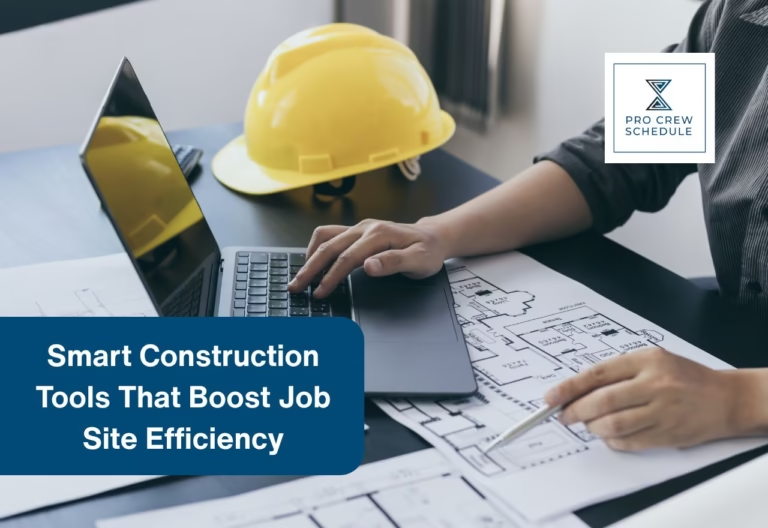Over the years, there has been a digital revolution in the construction industry. For a long time, the construction was characterized by manual tasks and scattered communication. However, things are changing quickly in this field. Comparing today’s job sites with those from ten years ago, general contractors and project managers now use automated tools and data-based plans.
Manufacturing and other fields have been using technology to change for decades, but the construction industry has been slower to catch on. Smart construction is transforming how projects are planned, built, and managed very quickly. It does this by using the latest digital technology, data analytics, and automated processes. This technology revolution solves problems in the sector, such as low output, budget overruns, safety issues, and environmental damage. It creates building methods that are more efficient, last longer, and generate more revenue, from the planning stages to the final inspection and control of the building itself.
While more work getting done is appealing, smart tools cost a lot of money up front. The main question is whether or not the improvements in speed, accuracy, and safety that come from smart tools can be turned into real business value for building companies. In this article, we will discuss what smart construction is, its pros and cons, and whether it is financially smart for contractors and building companies to take advantage of these systems.
What Are Smart Tools in Construction?
Smart tools are construction gadgets and machines that use technology like sensors, Bluetooth, GPS, Wi-Fi, or cloud connections to gather information, monitor performance, or automate tasks. These tools are more advanced than regular hand or power tools because they have features like real-time tracking, digital measurements, repair planning ahead of time, and more.
Using smart tools in construction can improve processes at all stages of a project by putting together an ecosystem where data flows easily between systems, stakeholders, and physical parts. At its core, this method includes:
- Digital tools for working together that link all project participants
- Getting and analyzing info from many sources in real time
- Tasks that are dangerous or repetitive can be automated.
- Advanced tools for visualizing data to help plan and carry out projects better
- Digital accuracy makes prefabrication and modular building possible.
- Smart methods for keeping an eye on quality, safety, and progress
What Are the Commonly Used Smart Tools in Construction?
Because of their growing use, it’s important to know why smart tools are becoming more popular. They make work easier and less likely to go wrong, but require a change in how people think and do things to be effective. If you work in a field where mistakes cost a lot of money and time, you should look into anything that can boost output, cut down on rework, and make things safer. In this section, let us take a look at the commonly used construction technologies.
Building Information Modeling (BIM)
Building Information Modeling, or BIM, is one of the core tools that is making this change possible in construction. BIM makes 3D models instead of 2D drawings, which feature geometry, spatial connections, geographic data, and building properties. Before work starts, this technology can help people see what the building will look like once completed. Advanced BIM allows you to simulate building, estimate costs, and plan for maintenance. It can also let you find clashes, which cuts down on redo, and it also lets you precisely build things off-site.
Smart Sensors and the Internet of Things (IoT)
Smart sensors and the Internet of Things (IoT) are used to track equipment location, usage, weather, and building quality. Use, repair needs, and operator behavior are all tracked by maintenance sensors to make things safer and more efficient. Wearable tech keeps track of where workers are, detects falls, and checks vital signs to prevent accidents.
Drones
Nowadays, drones have changed how sites are surveyed, inspected, and watched. With cameras, LiDAR, and thermal sensors, they can get detailed information about a place in hours instead of days. Teams can use this aerial data to keep track of work, check quality, find safety issues, and make “as-built” documents.
Robotics and Self-Driving Tools
Robotic systems can now perform dangerous, precise, or repetitive tasks in construction. They ensure quality remains consistent, reduce labor costs, and enhance safety by limiting human contact. Robots do things like finishing concrete, putting up drywall, and working with stone and brick.
Artificial Intelligence (AI) and Machine Learning
AI and machine learning look at a lot of data about building projects and find patterns that people would miss. Because of these tools, you can predict timelines and costs, automatically track progress, improve the order of building and managing resources, identify safety risks before they occur, and control quality.
Why Smart Tools Are Useful in Construction
When it comes to different kinds of building work, smart tools are useful in many ways. Here are some of the main benefits:
Increase Efficiency and Productivity
Smart construction technologies solve the industry’s long-standing problems with low output. Automated systems can handle boring, time-consuming chores, allowing your team to focus on more important tasks. Less rework, better use of resources, reduced downtime, and automating time-consuming jobs all lead to gains.
Improved Quality
Communication problems, missing information, and mistakes made by people often lead to quality problems in building. These issues can be lessened by smart building technologies that offer complete, easy-to-find data and automated checking systems. Real-time quality tracking with sensors and computer vision helps teams find and fix problems before they get too expensive. As a result, better buildings are provided with fewer problems and warranty claims afterward.
Save Money
Smart technology can significantly reduce project costs by using AI to optimize resource use and predict potential problems. It’s like having a vision ball that helps you avoid mistakes that cost a lot of money.
Better Performance in Safety
Even though construction is still one of the most dangerous fields, smart technologies are making that less true. Wearable devices and location tracking are examples of connected worker solutions that make it possible to monitor site conditions and worker behavior in real time. By looking for patterns in site data, machine learning algorithms can find dangerous situations. Proximity sensors also keep workers and building equipment from running into each other. This means that accidents will happen less often and your team will be safer at work.
Better Sustainability and Reduce Waste
Smart construction makes it easier to precisely buy and use materials, which helps the industry’s big waste problem. Digital fabrication and modular building methods further reduce waste by making manufacturing processes more efficient. BIM’s energy efficiency modeling helps architects design buildings that use less energy, while monitoring and control systems ensure that buildings use the least amount of energy while they’re running.
Giving Data and Reports
Using, maintenance, or weather data can be stored and used by many smart tools, which can be very helpful for the following:
- Keeping track of and reviewing projects
- Maintenance based on estimates
- Checking how long equipment lasts
- A study of performance
Having this information helps people make better decisions and see things more clearly across teams and job places.
Challenges in Using Smart Tools in Construction
Smart tools offer many benefits, but there can also be challenges in using them. In this section, let us look at some of the common challenges:
Needs for Training and a Skills Gap
Many traditional construction workers and project managers lack the expertise required for smart building. Everyone in the firm, from the top down, needs to learn a lot about this new technology, such as how to fly drones and how to look at BIM models. Training or “onboarding” new tools is often necessary and costs time and money. People who aren’t particularly adept with technology might not enjoy the changes or might have problems using the new tools correctly. Businesses need to invest in rigorous training programs to get the most out of the technology they buy.
High Upfront Investment
Smart buildings have a big return on investment (ROI) over time, but they can cost a lot at first. This is especially hard for smaller companies that don’t have much money to spend. In response, the industry is making its pricing plans more flexible by adding features such as subscription-based services that lower the initial costs.
Compatibility with Current Systems
Not all smart tools work well with other smart tools or with apps that you already have. A tech stack that is not well put together can make things less efficient.
Dependency on Connectivity
Some smart tools need to connect to Wi-Fi or a cell network, which might not work well on job sites that are far away or in rural areas. This could make things less useful or cause delays.
Issues with Maintenance
Updating software, managing batteries, and fixing problems are all tasks that smart tools need, adding another level of management. Your team might not have a backup plan if the tech breaks.
Possible Data Theft and Safety
While being able to stop tools from afar is useful, the security risks are growing. Tool tracking systems that keep private information about the job site or area must be kept safe.
How to Train Your Construction Team in Using Smart Tools
Before you start using smart tools for building, you should first figure out what you need and where you can improve. Next, choose one or two technologies that will give you the best return on your money. Then, provide your employees with training and collaborate with tech experts to ensure the adoption goes smoothly and the project is a long-term success.
1. Choose A Tool That Fits Your Needs
Figure out what parts of your building process can be made better by technology, like planning, talking to people, or surveying the place. Start with one or two smart tools that will have a direct effect on your work, like a tracked drill, a connected laser level, or a drone for mapping the site.
2. Invest in Skill Development and Training
Spend money on training to make sure your team knows how to use the technology. Even the best tools are useless if people do not agree with them. Make sure that the people who work for you know how to use the new technology well. Spend money on classes or hire professionals to teach. You can also work with technology companies to ensure that new solutions are implemented quickly and easily.
3. Check the ROI
Keep track of how much time, work, or stuff you save. This helps you make the case for more funding and shows your team and stakeholders how valuable the work is.
4. Get Ready for the Future
There is an initial cost, but the time, money, and resources saved over time will often be greater than the original cost if utilized efficiently. Know the level of accuracy you need for the job before buying the tools, so you do not waste money on unnecessary precision.
5. Use a Construction Management Software
When you use smart tools with building management software, you can plan, budget, and communicate more effectively.
What is Next for Smart Construction
Soon, digital tools will be an important part of the building business. Given the current trends, it is possible to guess which styles will be the most popular in the near future. As these tools get better and more integrated, the following changes are likely to happen:
Robotics and Autonomy Will Expand
There will be more and more autonomous and semi-autonomous tools working on construction sites with people. From automatic digging to automated delivery of materials, these systems will perform dangerous and repetitive tasks while people supervise and handle more specialized work.
Design and Planning Driven by AI
With generative design tools that can generate and compare thousands of building options based on specific goals and constraints, AI will play a bigger part in the design phase. These systems don’t just consider cost; they also evaluate how easy they are to build, how efficiently they use energy, and how the people who live there feel.
More Efficient Building Processes
The use of smart trackers will improve logistics as the building industry becomes more digital. Powerful construction management software will cut down on downtime and keep work processes running smoothly.
Reducing Wastes
Cutting down on waste is a very important part of building, both during the work itself and as a feature of newly built homes. For instance, builders can create an automated system for managing heating that changes thermostats based on the temperature inside and outside the home.
Increase in Automated Processes and Robotics
Smart construction methods might mean that fewer people are needed to finish a job. But the use of smart tools also means that workers need more skills. The increasing use of robotics in building is one of the most likely trends of the future. It includes using drones for surveillance, self-driving cars to transport building supplies over long distances, and robots that can be controlled remotely to perform tasks in hazardous environments, such as at heights.
Key Takeaways
Smart construction is now essential for companies that want to stay competitive in the building business. Early adopters show big improvements in quality, safety, productivity, and profits. This puts more pressure on traditional businesses to accept digital transformation. In fact, the digital transformation in the construction business is similar to changes that have already happened in finance, manufacturing, and other fields. People who can adapt will do well in this new world, making more money while constructing better buildings more quickly. For owners, the perks include faster project completion, better quality, lower costs over the building’s lifetime, and improved performance.
As this technology revolution continues, mastering these digital tools and the organizational changes needed to use them well will become a bigger part of what it means to be a great construction professional. People who are ready to see smart construction not just as a set of tools but as a whole new way of building will be successful in the future.







